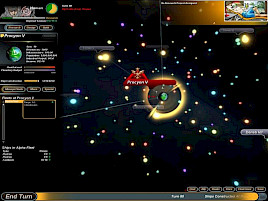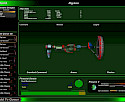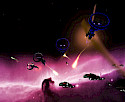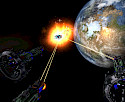Sword of the Stars Preview
So, what hit me? Firstly, it's a strategy game. Secondly, it's in space. Exactly what I have been waiting for and a very rare breed lately, so it definitely attracted a lot of my attention. So much of it actually that I was a pain in the arse long enough for the Strategy Core to get a preview version and give it to me just to get me off their (our) backs.
Let's not be fooled - Sword of the Stars (SotS) has a lot to achieve if it is to impress.
It promises a turn-based empire building strategy, which brings the Total War series to mind. It promises this gameplay to occur in space and that will cause the game to be compared with the giants like Master of Orion, Imperium Galactica and Galactic Civilizations. And it promises opera-like real-time 3D space battles, something in which Nexus: The Jupiter Incident spoiled us hugely.
Now let's see what SotS is all about.
General
I started by setting up a game with a relatively small galaxy of 60 stars in a spherical shape. Then I picked a race. To pick a race in SotS is much more than choosing the right racial characteristics. SotS only have four predetermined races, but these bring more differences to the game than the vast numbers of slightly statistically differentiated races in some other games. Each race brings a unique way of faster-than-light (FTL) space travel as well as some racially-specific technologies to research during the game. Also four players is not a limit. You can have up to eight players (empires) and if you wished all of them could be of the same race.
Humans travel along node lines that connect stars, but not each star to every other. What you get is a nice net of node lines that usually connect nearby stars while some connections are "missing". This means that you may need to travel by multiple stars to get to a neighbouring star. While you can travel slower than light (if node lines to the star don't exist or you haven't found them yet) it is always way slower than the route through the nodes.
Other races have other ways of travel - Hivers, an insect race, always travel slower than light and it takes a lot of time to get anywhere, but when they do arrive they deploy a sort of stargate and teleport the ships through instantly, bound only by the network capacity, determined by the number of existing gates.
Tarkas, a warrior reptilian race, and Liir, telepathic and telekinetic dolphin-like aquatic creatures, both have a similar, most "natural" direct star-to-star FTL travel but there are differences that also show on the battlefield.
The star map is phenomenal. It can fully rotate, zoom and you can centre it on any planet. It may put some strain on the people that have problems orienting in open space, but after a while anyone will start recognizing the structure of the galaxy. It is easier with humans who see a more prominent net of node lines among the stars, other races have slightly bigger problems. Everything is nicely rounded out with the accessible list of colonies and fleets.
Colony management is simplified to sliders that distribute the money the colony makes to building infrastructure, building ships and terraforming. Empire management is similar. A pie chart tells you how much money you are spending on colonies, ship building, what your savings are etc.. A slider lets you determine the money for research.
SotS also have diplomacy. Rather simplified, but it has a big impact both on a single player game as well as the multiplayer. I wasn't able to test multiplayer with the preview, but the impact of diplomacy is always bigger in multiplayer than in single player. First contact with a new kingdom always sets the weapons on your ships to locked, so it's up to you and the opponent to decide whether to start a war immediately, wait a little bit and strike in force later or try to get to know each other and sign a non-aggression agreement or even an alliance.
Research
After starting a game one should immediately start researching new technologies. They bring a huge difference to the game if used properly. Some techs are usable on the battlefield, others have an impact on your empire's productivity and economy.
The research screen is an interface in the form of a cylinder viewed from the center. The technologies are divided into groups distributed over the base of the cylinder and sometimes the technologies from different groups intersect on the cylinder to bring an "interdisciplinary" tech. The preview version research cylinder rotates with the same speed no matter how zoomed in on a certain tech the view is so it is more or less necessary to zoom out before rotating. Also it would be nice if you were able to set up a research queue since it's easy to miss the completion of research and valuable turns may pass before you start a new research. Then again, during the missed turns the money isn't spent (unless you are building ships) and you can boost the research later by adding extra funds from the treasury.
By the way, it's more or less impossible to learn the ideal research line in SotS because some techs are randomly disabled for each game you play. Meaning that the big gun you were racing for may not be there to save you. You'll just have to find another way to prevail!
Ships, the beautiful ships
Among those techs that make a difference on the battlefield some are weapons and some bring new types of ship sections. This is where SotS truly excels - building ships.
These come in three sizes; destroyers, cruisers and dreadnoughts. Each ship is composed of an engine section, a mission section and a command section that you can combine to create a huge number of different ship combinations - classes. When I researched deflectors (giving the ship a chance to repel projectile weapons) for instance, the finished research added a new kind of section into the design interface. It turned out to be a mission section for the destroyers but it only took a command section in a cruiser or a dreadnought, which leaves the mission section open for other choices.
The mission section can be said to be the most important in a ship, because it defines the ship's purpose. Among these you can find a colonizer, repair, armour, CnC section and the like. The command section gives an added value to a ship so to speak. You can always pick a standard command section. The hammerhead section will take more beating before blowing up and the fire control section will help all the weapons to fire more accurately but is less armoured. Engine sections are what their name suggests. The better the engine section, the faster the ship and possibly some other extras that I won't spoil for you.
When you pick all three sections that will form the ship you will also need to select the weapons. There are small, medium and large turrets on the sections and you can place the appropriate weapons on them. Some weapons demand a medium or a large turret and you can't place them on a turret smaller than their demand while vice versa is always possible. Choosing a smaller weapon in a larger turret will simply bring a larger number of smaller weapons to the turret where a single large one could have been. Some weapon placements are reserved for missiles and other heavy weapons.
The only drawback I saw in the design interface is the inability to take a better look at the ships you've constructed, zooming on them and spinning them around. You can do that during the battle, but some ships will (with luck) never participate in them.
Naming a ships class is the end of the design process. You can also create multiple classes with same sections and armament, so if naming individual ships is your secret love, you won't be robbed of it.
There are also planetary defensive platform for all three ships sizes. This is a single section satellite, packed with weapons to protect your colonies and can't be moved through space. Each colony can have ten small satellites, depending on the size of the colony ten medium and, for very large planets, ten dreadnought-size ones can be added. They all circle the planet in a single ring and with the same speed. Before some of you think that you've just found a mistake in the game, let me tell you that some "mistakes" were intentionally made to either not kill the computer or to improve the gameplay. Ships having engines only in the engine section is another one of those.
Battles and the field of war
Both the length of the strategic turn and the length of the battles can be set at the beginning of the game - which is great for multiplayer. Why limit the battle lengths? This bothered me at the beginning but it turned out to be an innovative feature that adds a lot to the gameplay. It prolongs the (larger) battles over multiple turns and allows the reinforcements to arrive, you can make some on-the-fly repairs and so forth.
Battles are also limited by the command points of the CnC ship. You can only command as many ships as you have CnC points. For instance - the lowest CnC destroyer gives you 20 command points. It itself takes 2 points (being a destroyer), so it leaves 18 points for 9 more destroyers or three cruisers each demanding 6 points or one dreadnought requiring 18 points or any combination in between. Anyway, you better not plan an invasion without the CnC ship. Two cruisers are just not enough. The command points system and the time limit bring for some really interesting battles.
SotS sport a 3D real-time battlefield with an intentionally induced drawback - a 2D command plane to make the battles less confusing. So you boss the ships around in 2D while they also take the third axis into account when they need to escape collision or when a weapon shock shoves them away from the plane. Around the planets this plane is an equatorial (judging from the wireframe seen in the sensors screen) plane in which the satellites circle as well.
This 2D plane does make the battles less confusing, but I am convinced the false up and down feeling that accompanies the 2D plane could be avoided. If you are able to understand the strategic 3d starmap, you can also use a tactical 3D battle map. Nexus: The Jupiter incident showed this quite clearly. The 2D plane also doesn't allow for some great 3D formations already seen in Nexus, Homeworld(s) and so forth.
Creating formations and groups in SotS is possible even previous to the battle if you have a CnC ship in the fleet. Placing ships in formation is very easy, but on the battlefield the formation becomes useless very quickly, especially since you can't rotate it Total War style. It does help to survive the first contact if you know on which side the enemy will turn up though.
I was a bit surprised by the relatively bad speed management of the ships if they are left to fight it out on their own in the preview version. You can give basic commands to groups or individual ships like close to attack, but I would only recommend such a command once the ships have already stopped and started shooting all over. Otherwise your ships will accelerate to full speed and disregard the fact that the enemy ships are also moving - in the opposite direction. They will only start turning and decelerating once they get past the enemy, which means that the enemy ships will get out of range in an instant and your planet, CnC ship, gateship and whatever you had stashed back there will be open for destruction. When your ships return, it is usually all over. Not to mention how much I cursed when my first dreadnought crashed into the planet because I had it on the close to attack and it forgot all about the gravity and the need to decelerate. Luckily you can micromanage the movement of the ships so such problems can be overridden with some more personal engagement.
The game lacks commands like "guard this ship". In Nexus ships were able to be set to guard others and they gracefully danced around them (also not being bound by the up and down concept of a 2D plane) to intercept all the incoming dangers, attacking only threats to the guarded ship, be it missiles or other ships. The guard command would also give more meaning to dedicated ships like point-defense destroyers etc. Since this is not present you have to micromanage some more...
I know I should stop complaining and this preview has already reached unprecedented proportions, but another feature that I sorely missed in the preview version was the ability to speed up the time in battles. When you are attacking a defenceless planet or defending your gateship in a sector with other occupants not attacking those four minutes (standard battle timelimit) will feel like eternity. This is rare, but all the more annoying. I could simply autocalculate the battle, but then the gate wouldn't survive. Numbers in an equation can bring a whole lot different result than a battle played by the player.
Conclusion
Let's wrap this preview for the people who skip to the end.
Is Sword of the Stars everything I have been waiting for in a space empire building strategy?
No, not at all.
Is it the closest one yet?
Yes, in my opinion it is.
I had loads of fun playing even with the preview version. You wouldn't believe how much fuss there can be around 60 stars. Took me about 40 hours and I must admit my victory wasn't assured until the very end. If the AI took the opportunity it had when it invaded with 80 ships while I took some time off, doing research, building no ships - I would have been defeated for sure. The AI setting was always at normal and it was a preview version, so we can expect even more in the final game. The mix of features like battle time limit, CnC points, modular ship building, four totally different ways of space travel, nice battles, a random tech tree AND some scary secrets that the space hides and that I'm not at liberty to talk about… makes a superb game.
Kerberos created a game well worth our attention and the team promised to build upon the fundations they made. I admit I have written some negative points, too, but one must understand that the fans will never be completely satisfied. Each fan has an idea or ten what in his/her view could and should be added to the game as you can read at the official SotS forums.
If anyone has any doubts about the game, I advise him to go check out the SotS homepage and Wiki and read some background information on the races. It doesn't change the game, but it reads like good science fiction and it also shows to what depth Kerberos is prepared to go with the game. This gives me hope of a new space strategy series to hold our short and longterm attention, starting at August 22nd, when the game is out.
(editors note: If you think this sounds interesting, be sure to check out our E3 2006 interview)





